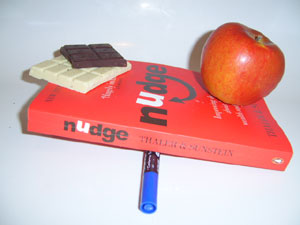 A fresh apple – or a chocolate bar? ‘The Nudge‘ describes how the layout of food in a school cafeteria decided what the children were going to eat.
A fresh apple – or a chocolate bar? ‘The Nudge‘ describes how the layout of food in a school cafeteria decided what the children were going to eat.
The cafeteria manager could decide if the children were going to choose salads and fruit – or fried food and sugary desserts – just by moving the same menu items around. Same children, same food, same free choice, but a different outcome.
The authors build out from this example to explain how we are ‘on auto-pilot‘ much of the time. Instead of making rational choices in a prioritised and systematic way, we are influenced by minor and often irrelevant factors as we muddle along through our lives. We spend more time choosing a new TV than thinking about our pension.
The book has a good message for webby people, because it hardly mentions the internet. It helps us to think about what we are doing and develops some interesting themes. The examples are from pension plans, ATMs, organ donation schemes, and the bathroom at Schipol Airport among others. The book references 152 academic studies – mainly from economics and psychology.
The main themes are
Choices. People are influenced by the order of choices – like the school cafeteria. And the number of choices. Sometimes too much choice causes irrational choice: 200 investment plans are available so investors pick the one with a free pen – or they bail out and ‘postpone’ it for another day.
The main thrust of the book is that the way choices are presented is crucial in deciding what people do. So crucial that the book gives this concept a title: ‘Choice Architecture‘. And the people arranging and framing the choices are ‘Choice Architects’.
Defaults. Opting in – or out of organ donation is the example. Inertia is very strong and people are very happy to live most of their lives on ‘factory settings’. Powerful if you decide those settings.
Social pressure. A campaign explained that over 90% of Minnesotans were already ‘doing the right thing’ by filing their tax returns on time – this was the only message that increased the rate of filing. Messages that didn’t work were those that threatened fines or extolled the good work that taxes went to pay for.
The book develops these themes with nuances and dozens of examples. Most of the ideas seem obvious when you think about them – but that’s the point: people aren’t thinking. So here’s my nudge:
Read the book yourself – or go through your own life on ‘factory settings’…
Related articles
- Nudge theory gets a chance in the UK (transcapitalist.com)
- First Obama, now Cameron embraces ‘nudge theory’ (independent.co.uk)
- Nick Marsh: Grocery store choice architecture (nudges.org)
- Nudging is not enough (redux) (herd.typepad.com)
- The kindly words of Nudge are Cameron’s ideal veneer | Peter Wilby (guardian.co.uk)

